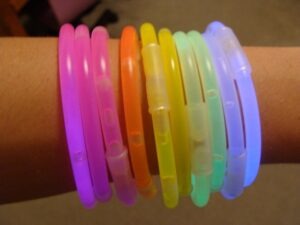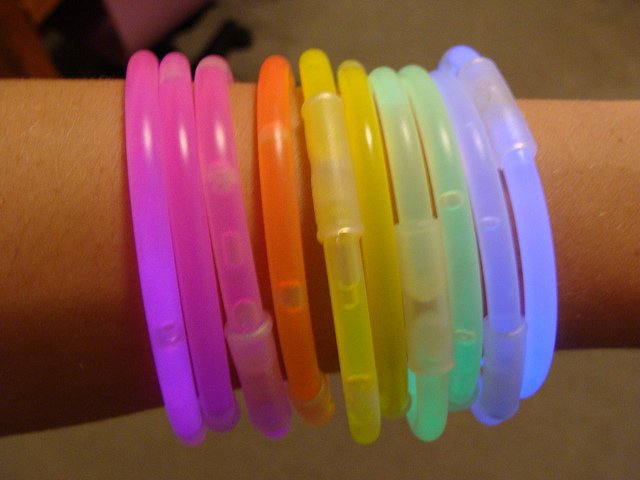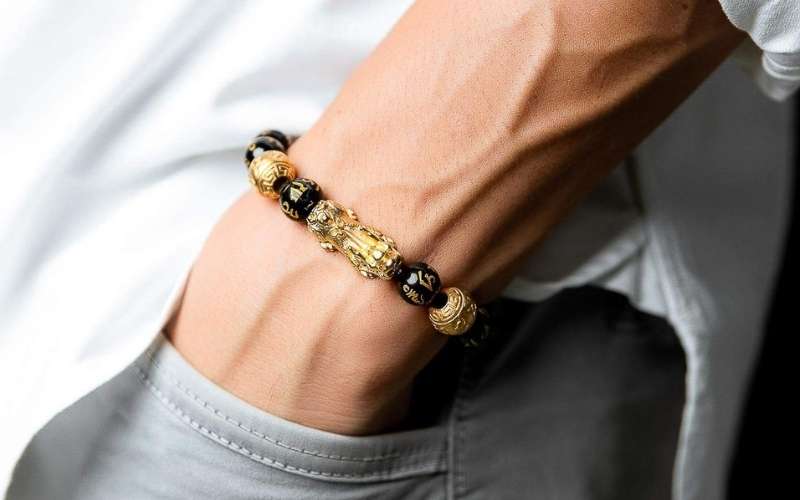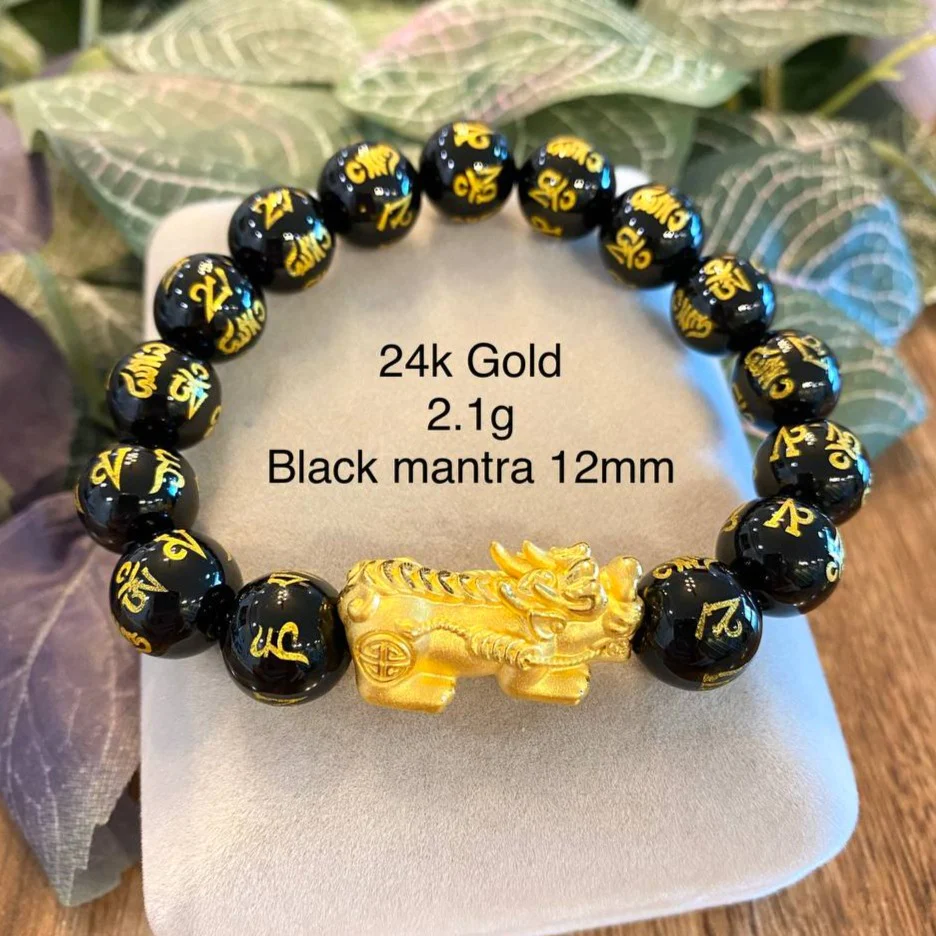Glow bracelets are a popular accessory for parties, concerts, and other nighttime events. They are often used by children and adults alike as a fun and colorful way to light up the night.
However, there has been some concern about the safety of glow bracelets, particularly regarding their toxicity.
Some people have raised questions about whether the chemicals used in glow bracelets are harmful to human health. The main ingredient in glow bracelets is a chemical called phenyl oxalate ester, which reacts with hydrogen peroxide to produce a glowing effect.
While this chemical is generally considered safe, there have been reports of skin irritation and other adverse reactions in some individuals who have come into contact with it.
Despite these concerns, there is no clear evidence that glow bracelets are toxic or pose a significant risk to human health. Most people can use them safely without any problems. However, it is always a good idea to take precautions when using any type of chemical or product, especially around children or individuals with sensitive skin.
Chemical Composition of Glow Bracelets
Luminous Compounds
Glow bracelets contain luminous compounds that produce light when activated. These compounds are typically made up of a mixture of fluorescent dyes and a small amount of a chemical called hydrogen peroxide.
When the two are mixed together, a chemical reaction occurs, causing the dye to emit light.
The fluorescent dyes used in glow bracelets are generally considered safe and non-toxic. They are commonly found in laundry detergents, soaps, and other household products.
However, some people may be allergic to certain dyes, so it is always a good idea to check the ingredients list before using a glow bracelet.
Hydrogen peroxide, on the other hand, can be harmful if ingested or if it comes into contact with the eyes or skin in high concentrations. However, the amount of hydrogen peroxide used in glow bracelets is typically very small and is not considered dangerous.

Plastic Materials
The plastic materials used to make glow bracelets are typically made of polyethylene or polypropylene. These materials are considered safe and non-toxic. They are commonly used in food packaging, medical devices, and other everyday products.
However, some glow bracelets may contain additional chemicals or additives, such as phthalates or bisphenol A (BPA), which have been linked to health concerns in some studies. To ensure the safety of glow bracelets, it is important to purchase them from a reputable source and to check the ingredients list before use.
Toxicity and Safety Concerns
Glow bracelets have become a popular accessory for parties, concerts, and other events. However, there are concerns about their safety and toxicity. Here are some of the key things to know about the potential risks of glow bracelets.
Skin Exposure Risks
Glow bracelets contain chemicals that can cause skin irritation or allergic reactions in some people. The chemicals are sealed inside the plastic tube, but they can still leak out if the bracelet is punctured or damaged.
If you experience any itching, redness, or swelling after wearing a glow bracelet, remove it immediately and wash the affected area with soap and water. If the symptoms persist or worsen, seek medical attention.
Ingestion Hazards
Glow bracelets are not meant to be eaten or ingested in any way. If a child or pet accidentally ingests a glow bracelet, it can cause nausea, vomiting, and other digestive problems.
The chemicals inside the bracelet are not toxic in small amounts, but they can cause discomfort and should be avoided. If you suspect that someone has ingested a glow bracelet, call your local poison control center or seek medical attention immediately.
Proper Usage and Handling
Instructions for Safe Use
When using glow bracelets, it is important to follow some basic safety guidelines to ensure that they are used properly and safely.
First, it is recommended that the user reads and follows the instructions provided with the product. This will help ensure that the user is aware of any potential hazards associated with the product and how to avoid them.
It is also important to avoid puncturing or cutting the glow bracelet, as this can cause the chemicals inside to leak out and potentially cause skin irritation or other adverse effects.
Additionally, users should not attempt to ingest or break open the glow bracelet, as this can also be dangerous.
Finally, it is important to supervise children when they are using glow bracelets, as they may not be aware of the potential hazards associated with the product.
Disposal Guidelines
After use, glow bracelets should be disposed of properly to avoid any potential harm to the environment.
Users should check with their local waste management authority to determine the proper method of disposal in their area.
In general, glow bracelets should not be disposed of in regular household trash, as they may contain chemicals that could be harmful to the environment. Instead, they should be disposed of in accordance with local regulations for hazardous waste.
Users should also avoid burning or incinerating glow bracelets, as this can release harmful chemicals into the air. Instead, they should be disposed of in a way that is safe and environmentally responsible.
Regulatory Standards and Certifications
Consumer Product Safety Commission
The Consumer Product Safety Commission (CPSC) is an independent agency of the United States government that regulates the safety of consumer products. Glow bracelets fall under the category of novelty items and are subject to CPSC regulations.
The CPSC has not issued any specific regulations or warnings regarding glow bracelets, indicating that they are generally considered safe for consumer use.
Relevant Industry Certifications
There are several industry certifications that apply to glow bracelets, including the ASTM F963-17 Standard Consumer Safety Specification for Toy Safety and the European Union’s REACH (Registration, Evaluation, Authorization and Restriction of Chemicals) regulation.
ASTM F963-17 outlines safety requirements for toys and includes requirements for materials used in the manufacture of toys, including glow bracelets. REACH requires manufacturers to register and evaluate the safety of chemicals used in products sold in the European Union, including glow bracelets.
Glow bracelets that comply with these certifications are considered safe for consumer use. However, not all glow bracelets on the market may meet these standards, so consumers should always purchase glow bracelets from reputable retailers and inspect them for any signs of damage or tampering before use.
First Aid and Emergency Response
Skin Contact Protocols
If a person comes into contact with the contents of a glow bracelet, it is important to act quickly to minimize any potential harm. The following steps should be taken:
- Remove any contaminated clothing or jewelry.
- Wash the affected area with soap and water for at least 10 minutes.
- If any irritation or redness occurs, apply a cool compress to the affected area.
- Seek medical attention if symptoms persist or if the person experiences any difficulty breathing or swallowing.
Ingestion Treatment Procedures
Ingesting the contents of a glow bracelet can be dangerous, especially for young children. If a person ingests the contents, the following steps should be taken:
- Call Poison Control immediately.
- Do not induce vomiting unless instructed to do so by Poison Control.
- If the person is conscious, have them rinse their mouth with water.
- Seek medical attention immediately.
It’s important to note that the contents of glow bracelets are generally non-toxic and are not likely to cause serious harm. However, it’s always better to err on the side of caution and seek medical attention if there is any concern.





